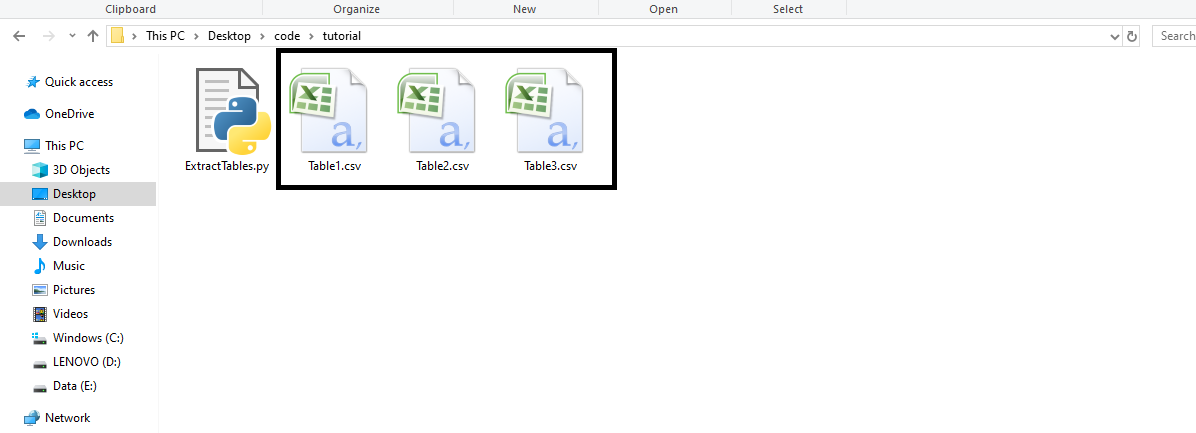HTML is the standard language to create web pages, and it is generally used to structure the text, images, other elements on a web page. HTML can represent the text data in various formats such as links, normal text, tables, lists, etc.
Let's say that you have an HTML or you want to grab the HTML web page from the internet and wish to extract the table data to analyze or crunch the data.
Here in this Python tutorial, I will walk you through the Python program on how to extract table data from the HTML web pages and save it locally in CSV files. But before we get to the main topic, let's discuss and install the libraries that we will be using in this Python tutorial.
Required Libraries
-
Python
requestslibrary
We will be using the
requests
library to send
HTTP GET request
to the web page and in response get HTML text data. To install the requests library, run the following pip command on your terminal or command prompt:
pip install requests
-
Python
beautifulsoup4Library
The beautifulsoup4 library is an open-source Python HTML & XML data extractor library. We will be using this library to extract table data from a HTML page using HTML tag names like <th>, <table>, <tr>, and <td>. You can install this library using the following pip command:
pip install beautifulsoup4
-
Python CSV Module
CSV (Comma Separated Values) is one of the modules in the Python Standard Library, and you do not need to install it separately. As its name suggests, we can use this module to read and write CSV files. To learn how to write CSV files in Python, click here .
Note: In this tutorial, we will be extracting data from HTML tables. Here, we assume that you have some knowledge about the usage of the HTML <table> tag along with other tags like <th>, <tr>, and <td>.
Convert HTML Tables into CSV Files in Python
Let's begin with importing the modules for our Python program.
import requests
from bs4 import BeautifulSoup
import csv
Now define a
Python variable
url
for the web-page URL
url= r"https://www.techgeekbuzz.com/difference-between-repeater-datalist-and-gridview/"
response = requests.get(url) #send get request
html_page = response.text #fetch HTML page
The
get()
function will send a get request to the URL, whereas
text
property will fetch the response HTML web page. Now we will parse the
html_page
using
BeautifulSoup()
module so we can extract the html_page using BeautifulSoup
find_all()
function.
page = BeautifulSoup(html_page, 'html.parser') #parse html_page
As in this tutorial we are only fetching tables data, let's extract all the tables present in the
page
.
tables = page.find_all("table") #find tables
#print the total tables found
print(f"Total {len(tables)} Found on page {url}")
The
find_all("table")
will return a list of all the <table> tags present in
page
. Now, we will loop through every
table
present in
tables
list, create the new CSV file, and write table data on the CSV file.
for index, table in enumerate(tables):
print(f"\n-----------------------Table{index+1}-----------------------------------------\n")
table_rows = table.find_all("tr")
#open csv file in write mode
with open(f"Table{index+1}.csv", "w", newline="") as file:
#initialize csv writer object
writer = csv.writer(file)
for row in table_rows:
row_data= []
#<th> data
if row.find_all("th"):
table_headings = row.find_all("th")
for th in table_headings:
row_data.append(th.text.strip())
#<td> data
else:
table_data = row.find_all("td")
for td in table_data:
row_data.append(td.text.strip())
#write data in csv file
writer.writerow(row_data)
print(",".join(row_data))
print("--------------------------------------------------------\n")
Now put all the code together and execute.
Python Program to Convert Web Page Tables to CSV files
import requests
from bs4 import BeautifulSoup
import csv
url= r"https://www.techgeekbuzz.com/difference-between-repeater-datalist-and-gridview/"
response = requests.get(url)
html_page = response.text
soup = BeautifulSoup(html_page, 'html.parser')
#find <table>
tables = soup.find_all("table")
print(f"Total {len(tables)} Table(s)Found on page {url}")
for index, table in enumerate(tables):
print(f"\n-----------------------Table{index+1}-----------------------------------------\n")
#find <tr>
table_rows = table.find_all("tr")
#open csv file in write mode
with open(f"Table{index+1}.csv", "w", newline="") as file:
#initialize csv writer object
writer = csv.writer(file)
for row in table_rows:
row_data= []
#<th> data
if row.find_all("th"):
table_headings = row.find_all("th")
for th in table_headings:
row_data.append(th.text.strip())
#<td> data
else:
table_data = row.find_all("td")
for td in table_data:
row_data.append(td.text.strip())
#write data in csv file
writer.writerow(row_data)
print(",".join(row_data))
print("--------------------------------------------------------\n")
Output
Total 3 Table(s) Found on page https://www.techgeekbuzz.com/difference-between-repeater-datalist-and-gridview/
-----------------------Table2-----------------------------------------
GridView,Repeater
Debut
GridView was introduced in Asp.Net 2.0,The Repeater was introduced in Asp.Net 1.0.
Columns generation
It automatically generates columns using the data source.,It cannot generate columns.
Row selection
It can select a row from the data source.,It cannot select rows.
Content Editing
Using GridView control, we can edit object content.,It does not support content editing.
In-built methods
It comes with built-in paging and sorting methods.,No built-in support for Built-in paging and sorting developer has to code.
Auto formatting and styling
In GridView we get inbuilt auto format and styling feature.,It does not support these features.
Performance
It is slower than Repeater.,Because of its lightweight, it is faster as compared to GridView.
--------------------------------------------------------
-----------------------Table3-----------------------------------------
GridView,DataList
Debut
GridView was introduced in Asp.Net 2.0 version.,DataList was introduced in Asp.Net 1.0 version.
In-built methods
It comes with built-in paging and sorting methods.,No built-in support for Built-in paging and sorting, the developer has to code for these features.
Build-in CRUD operation
It comes with built-in Update and Deletes Operations, so the developer does not need to write code for simple operations.,If developer use DataList then he/she has to write code for the Update and Delete operations.
Auto formatting and styling
In GridView we get inbuilt auto format and styling feature.,It does not support these features.
Customizable Row
We do not get Customizable row separator feature in GridView.,DataList has SeparatorTemplate for customizable row separator.
Performance:
Its performance is the lowest as compared to Repeater and DataList.,It is faster than the GridView.
--------------------------------------------------------
When you execute the above program, you will see that it will save the .csv file in the same directory where your Python script is located.

Conclusion
Here, we learned "How to convert HTML tables to CSV files in Python?" Also, this tutorial is a small demonstration of web-scrapping with Python. If you want to learn more about extracting data from web pages , you can read the official documentation of BeautifulSoup4.
People are also reading:





Leave a Comment on this Post